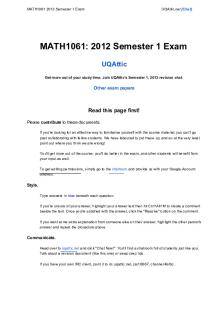Discrete and Contionuous Variables PDF

| Title | Discrete and Contionuous Variables |
|---|---|
| Author | Nay Myo |
| Course | Discrete Mathematics |
| Institution | Texas A&M International University |
| Pages | 4 |
| File Size | 139.7 KB |
| File Type | |
| Total Downloads | 52 |
| Total Views | 125 |
Summary
Download Discrete and Contionuous Variables PDF
Description
Comparison Chart BASIS FOR COMPARISON
DISCRETE VARIABLE
CONTINUOUS VARIABLE
Meaning
Discrete variable refers to the variable that assumes a finite number of isolated values.
Continuous variable alludes to the a variable which assumes infinite number of different values.
Range of specified number
Complete
Incomplete
Values
Values are obtained by counting.
Values are obtained by measuring.
Classification
Non-overlapping
Overlapping
Assumes
Distinct or separate values.
Any value between the two values.
Represented by
Isolated points
Connected points
Definition of Discrete Variable A discrete variable is a type of statistical variable that can assume only fixed number of distinct values and lacks an inherent order. Also known as a categorical variable, because it has separate, invisible categories. However no values can exist in-between two categories, i.e. it does not attain all the values within the limits of the variable. So, the number of permitted values that it can suppose is either finite or countably infinite. Hence if you are able to count the set of items, then the variable is said to be discrete.
Definition of Continuous Variable Continuous variable, as the name suggest is a random variable that assumes all the possible values in a continuum. Simply put, it can take any value within the given range. So, if a variable can take an infinite and uncountable set of values, then the variable is referred as a continuous variable. A continuous variable is one that is defined over an interval of values, meaning that it can suppose any values in between the minimum and maximum value. It can be understood as the function for the interval and for each function, the range for the variable may vary.
Key Differences Between Discrete and Continuous Variable The difference between discrete and continuous variable can be drawn clearly on the following grounds: 1. The statistical variable that assumes a finite set of data and a countable number of values, then it is called as a discrete variable. As against this, the quantitative variable which takes on an infinite set of data and a uncountable number of values is known as a continuous variable. 2. For non-overlapping or otherwise known as mutually inclusive classification, wherein the both the class limit are included, is applicable for the discrete variable. On the contrary, for overlapping or say mutually exclusive classification, wherein the upper class-limit is excluded, is applicable for a continuous variable. 3. In discrete variable, the range of specified number is complete, which is not in the case of a continuous variable. 4. Discrete variables are the variables, wherein the values can be obtained by counting. On the other hand, Continuous variables are the random variables that measure something. 5. Discrete variable assumes independent values whereas continuous variable assumes any value in a given range or continuum. 6. A discrete variable can be graphically represented by isolated points. Unlike, a continuous variable which can be indicated on the graph with the help of connected points.
Examples Discrete Variable Number of printing mistakes in a book. Number of road accidents in New Delhi. Number of siblings of an individual. Continuous Variable Height of a person Age of a person Profit earned by the company.
Conclusion By and large, both discrete and continuous variable can be qualitative and quantitative. However, these two statistical terms are diametrically opposite to one another in the sense that the discrete variable is the variable with the welldefined number of permitted values whereas a continuous variable is a variable that can contain all the possible values between two numbers.
Discrete vs Continuous variables: A Brief Overview. Discrete variables are countable in a finite amount of time. For example, you can count the change in your pocket. You can count the money in your bank account. You could also count the amount of money in everyone’s bank account. It might take you a long time to count that last item, but the point is — it’s still countable. Continuous Variables would (literally) take forever to count. In fact, you would get to “forever” and never finish counting them. For example, take age. You can’t count “age”. Why not? Because it would literally take forever. For example, you could be: 25 years, 10 months, 2 days, 5 hours, 4 seconds, 4 milliseconds, 8 nanoseconds, 99 picosends…and so on. You couldturn age into a discrete variable and then you could count it. For example:
A person’s age in years. A baby’s age in months. Take a look at this article on orders of magnitude of time and you’ll see why time or age just isn’t countable. Try counting your age in Planctoseconds (good luck… see you at the end of time!). Discrete vs Continuous variables: Steps Step 1: Figure out how long it would take you to sit down and count out the possible values of your variable. For example, if your variable is “Temperature in Arizona,” how long would it take you to write every possible temperature? It would take you literally forever: 50°, 50.1°, 50.11°, 50.111°, 50.1111°, … If you start counting now and never, ever, ever finish (i.e. the numbers go on and on until infinity), you have what’s called a continuous variable. If your variable is “Number of Planets around a star,” then you can count all of the numbers out (there can’t be an infinite number of planets). That is a discrete variable. http://www.statisticshowto.com/discrete-vs-continuous-variables/...
Similar Free PDFs

Variables and Expressions
- 3 Pages

Variables
- 5 Pages

Productivity variables
- 1 Pages

Variables Aleatorias
- 3 Pages

Forms (Variables)
- 2 Pages
Popular Institutions
- Tinajero National High School - Annex
- Politeknik Caltex Riau
- Yokohama City University
- SGT University
- University of Al-Qadisiyah
- Divine Word College of Vigan
- Techniek College Rotterdam
- Universidade de Santiago
- Universiti Teknologi MARA Cawangan Johor Kampus Pasir Gudang
- Poltekkes Kemenkes Yogyakarta
- Baguio City National High School
- Colegio san marcos
- preparatoria uno
- Centro de Bachillerato Tecnológico Industrial y de Servicios No. 107
- Dalian Maritime University
- Quang Trung Secondary School
- Colegio Tecnológico en Informática
- Corporación Regional de Educación Superior
- Grupo CEDVA
- Dar Al Uloom University
- Centro de Estudios Preuniversitarios de la Universidad Nacional de Ingeniería
- 上智大学
- Aakash International School, Nuna Majara
- San Felipe Neri Catholic School
- Kang Chiao International School - New Taipei City
- Misamis Occidental National High School
- Institución Educativa Escuela Normal Juan Ladrilleros
- Kolehiyo ng Pantukan
- Batanes State College
- Instituto Continental
- Sekolah Menengah Kejuruan Kesehatan Kaltara (Tarakan)
- Colegio de La Inmaculada Concepcion - Cebu










